Sydney High School Alcohol Abuse Prevention Project Plan NUR329
VerifiedAdded on 2022/12/22
|10
|2982
|69
Report
AI Summary
This report presents a comprehensive public health promotion project plan focused on preventing alcohol abuse among students at Sydney Boys High School. The project aims to address the increasing levels of alcohol consumption among teenagers, with a specific focus on primary prevention strategies. The report outlines the health promotion aims, which include helping students abstain from alcohol and assisting those who have already started drinking. It details the project's prevention management perspective, emphasizing primary prevention to educate students about the dangers of alcohol. The report identifies key stakeholders, including school management, teachers, public health officers, and the community, and outlines their roles in the project. The health message, 'avoid alcohol for better brain and body development,' is designed to resonate with the target group. The report describes various health promotion activities, such as parent meetings, poster campaigns, performances, hospital visits, and sports events. It also includes a detailed health promotion evaluation proposal, outlining methods for assessing the project's impact. The conclusion summarizes the project's goals and emphasizes the importance of primary prevention techniques to mitigate the negative effects of early alcohol consumption. The report is supported by a list of relevant references.
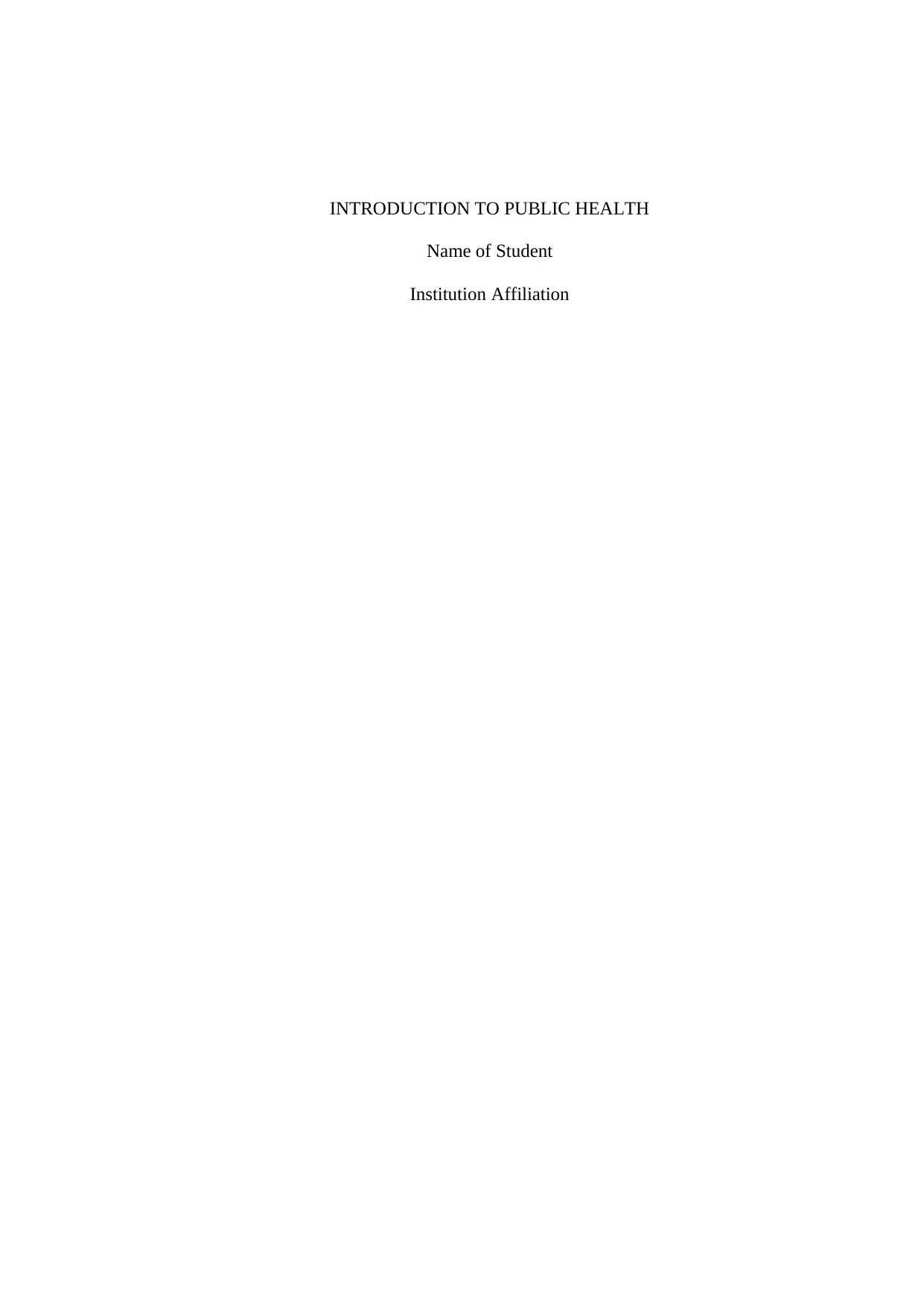
INTRODUCTION TO PUBLIC HEALTH
Name of Student
Institution Affiliation
Name of Student
Institution Affiliation
Paraphrase This Document
Need a fresh take? Get an instant paraphrase of this document with our AI Paraphraser
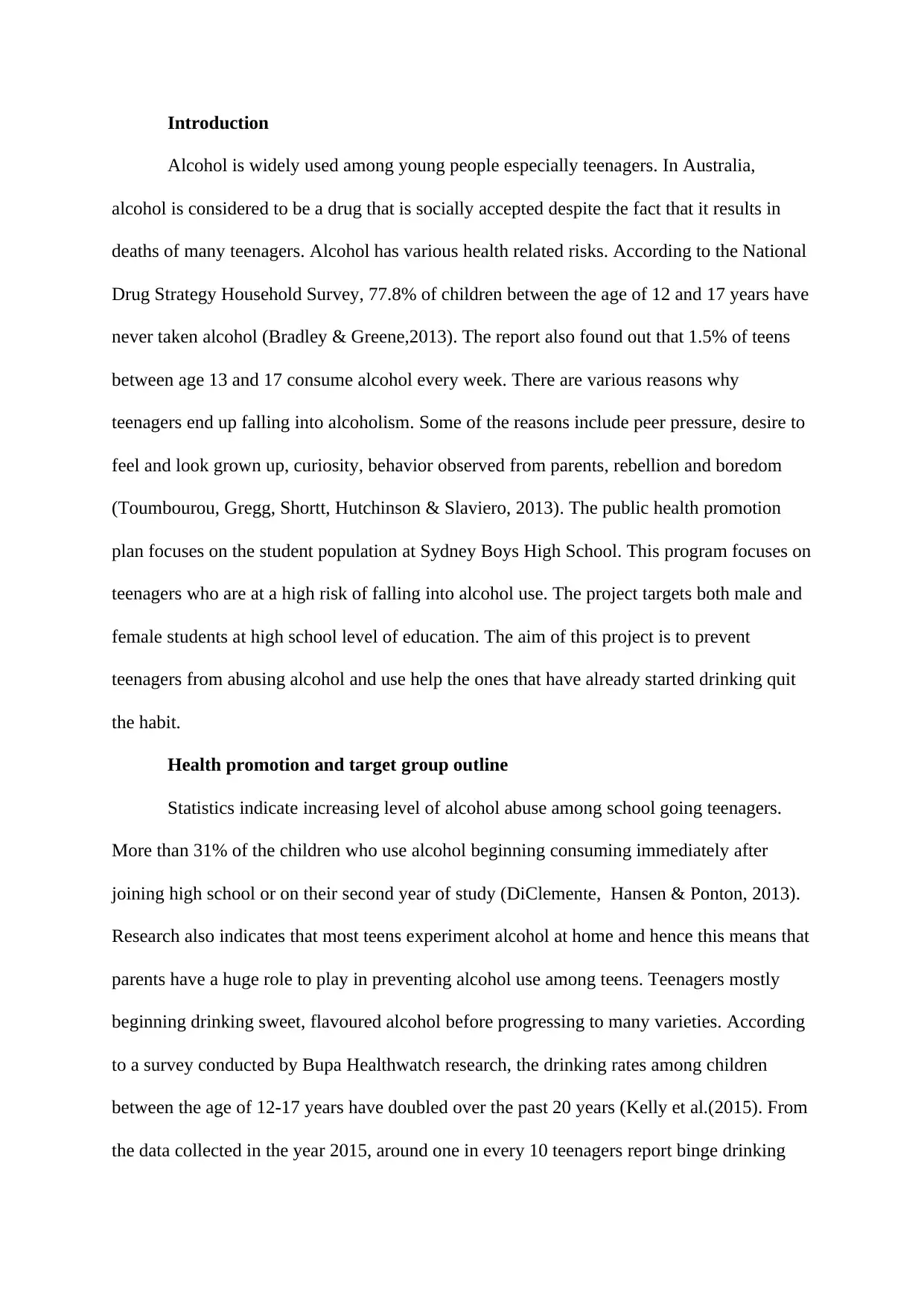
Introduction
Alcohol is widely used among young people especially teenagers. In Australia,
alcohol is considered to be a drug that is socially accepted despite the fact that it results in
deaths of many teenagers. Alcohol has various health related risks. According to the National
Drug Strategy Household Survey, 77.8% of children between the age of 12 and 17 years have
never taken alcohol (Bradley & Greene,2013). The report also found out that 1.5% of teens
between age 13 and 17 consume alcohol every week. There are various reasons why
teenagers end up falling into alcoholism. Some of the reasons include peer pressure, desire to
feel and look grown up, curiosity, behavior observed from parents, rebellion and boredom
(Toumbourou, Gregg, Shortt, Hutchinson & Slaviero, 2013). The public health promotion
plan focuses on the student population at Sydney Boys High School. This program focuses on
teenagers who are at a high risk of falling into alcohol use. The project targets both male and
female students at high school level of education. The aim of this project is to prevent
teenagers from abusing alcohol and use help the ones that have already started drinking quit
the habit.
Health promotion and target group outline
Statistics indicate increasing level of alcohol abuse among school going teenagers.
More than 31% of the children who use alcohol beginning consuming immediately after
joining high school or on their second year of study (DiClemente, Hansen & Ponton, 2013).
Research also indicates that most teens experiment alcohol at home and hence this means that
parents have a huge role to play in preventing alcohol use among teens. Teenagers mostly
beginning drinking sweet, flavoured alcohol before progressing to many varieties. According
to a survey conducted by Bupa Healthwatch research, the drinking rates among children
between the age of 12-17 years have doubled over the past 20 years (Kelly et al.(2015). From
the data collected in the year 2015, around one in every 10 teenagers report binge drinking
Alcohol is widely used among young people especially teenagers. In Australia,
alcohol is considered to be a drug that is socially accepted despite the fact that it results in
deaths of many teenagers. Alcohol has various health related risks. According to the National
Drug Strategy Household Survey, 77.8% of children between the age of 12 and 17 years have
never taken alcohol (Bradley & Greene,2013). The report also found out that 1.5% of teens
between age 13 and 17 consume alcohol every week. There are various reasons why
teenagers end up falling into alcoholism. Some of the reasons include peer pressure, desire to
feel and look grown up, curiosity, behavior observed from parents, rebellion and boredom
(Toumbourou, Gregg, Shortt, Hutchinson & Slaviero, 2013). The public health promotion
plan focuses on the student population at Sydney Boys High School. This program focuses on
teenagers who are at a high risk of falling into alcohol use. The project targets both male and
female students at high school level of education. The aim of this project is to prevent
teenagers from abusing alcohol and use help the ones that have already started drinking quit
the habit.
Health promotion and target group outline
Statistics indicate increasing level of alcohol abuse among school going teenagers.
More than 31% of the children who use alcohol beginning consuming immediately after
joining high school or on their second year of study (DiClemente, Hansen & Ponton, 2013).
Research also indicates that most teens experiment alcohol at home and hence this means that
parents have a huge role to play in preventing alcohol use among teens. Teenagers mostly
beginning drinking sweet, flavoured alcohol before progressing to many varieties. According
to a survey conducted by Bupa Healthwatch research, the drinking rates among children
between the age of 12-17 years have doubled over the past 20 years (Kelly et al.(2015). From
the data collected in the year 2015, around one in every 10 teenagers report binge drinking
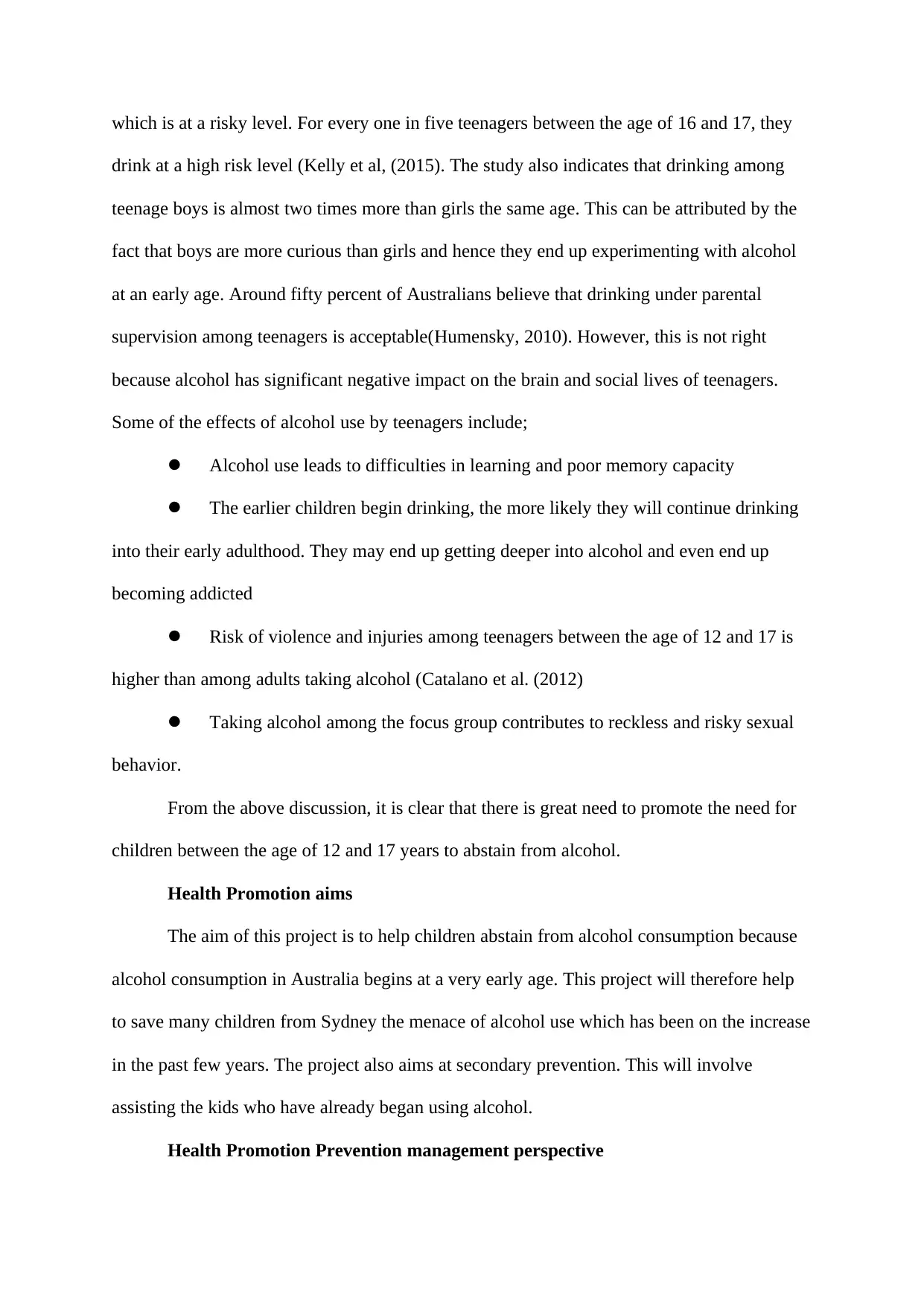
which is at a risky level. For every one in five teenagers between the age of 16 and 17, they
drink at a high risk level (Kelly et al, (2015). The study also indicates that drinking among
teenage boys is almost two times more than girls the same age. This can be attributed by the
fact that boys are more curious than girls and hence they end up experimenting with alcohol
at an early age. Around fifty percent of Australians believe that drinking under parental
supervision among teenagers is acceptable(Humensky, 2010). However, this is not right
because alcohol has significant negative impact on the brain and social lives of teenagers.
Some of the effects of alcohol use by teenagers include;
Alcohol use leads to difficulties in learning and poor memory capacity
The earlier children begin drinking, the more likely they will continue drinking
into their early adulthood. They may end up getting deeper into alcohol and even end up
becoming addicted
Risk of violence and injuries among teenagers between the age of 12 and 17 is
higher than among adults taking alcohol (Catalano et al. (2012)
Taking alcohol among the focus group contributes to reckless and risky sexual
behavior.
From the above discussion, it is clear that there is great need to promote the need for
children between the age of 12 and 17 years to abstain from alcohol.
Health Promotion aims
The aim of this project is to help children abstain from alcohol consumption because
alcohol consumption in Australia begins at a very early age. This project will therefore help
to save many children from Sydney the menace of alcohol use which has been on the increase
in the past few years. The project also aims at secondary prevention. This will involve
assisting the kids who have already began using alcohol.
Health Promotion Prevention management perspective
drink at a high risk level (Kelly et al, (2015). The study also indicates that drinking among
teenage boys is almost two times more than girls the same age. This can be attributed by the
fact that boys are more curious than girls and hence they end up experimenting with alcohol
at an early age. Around fifty percent of Australians believe that drinking under parental
supervision among teenagers is acceptable(Humensky, 2010). However, this is not right
because alcohol has significant negative impact on the brain and social lives of teenagers.
Some of the effects of alcohol use by teenagers include;
Alcohol use leads to difficulties in learning and poor memory capacity
The earlier children begin drinking, the more likely they will continue drinking
into their early adulthood. They may end up getting deeper into alcohol and even end up
becoming addicted
Risk of violence and injuries among teenagers between the age of 12 and 17 is
higher than among adults taking alcohol (Catalano et al. (2012)
Taking alcohol among the focus group contributes to reckless and risky sexual
behavior.
From the above discussion, it is clear that there is great need to promote the need for
children between the age of 12 and 17 years to abstain from alcohol.
Health Promotion aims
The aim of this project is to help children abstain from alcohol consumption because
alcohol consumption in Australia begins at a very early age. This project will therefore help
to save many children from Sydney the menace of alcohol use which has been on the increase
in the past few years. The project also aims at secondary prevention. This will involve
assisting the kids who have already began using alcohol.
Health Promotion Prevention management perspective
⊘ This is a preview!⊘
Do you want full access?
Subscribe today to unlock all pages.

Trusted by 1+ million students worldwide
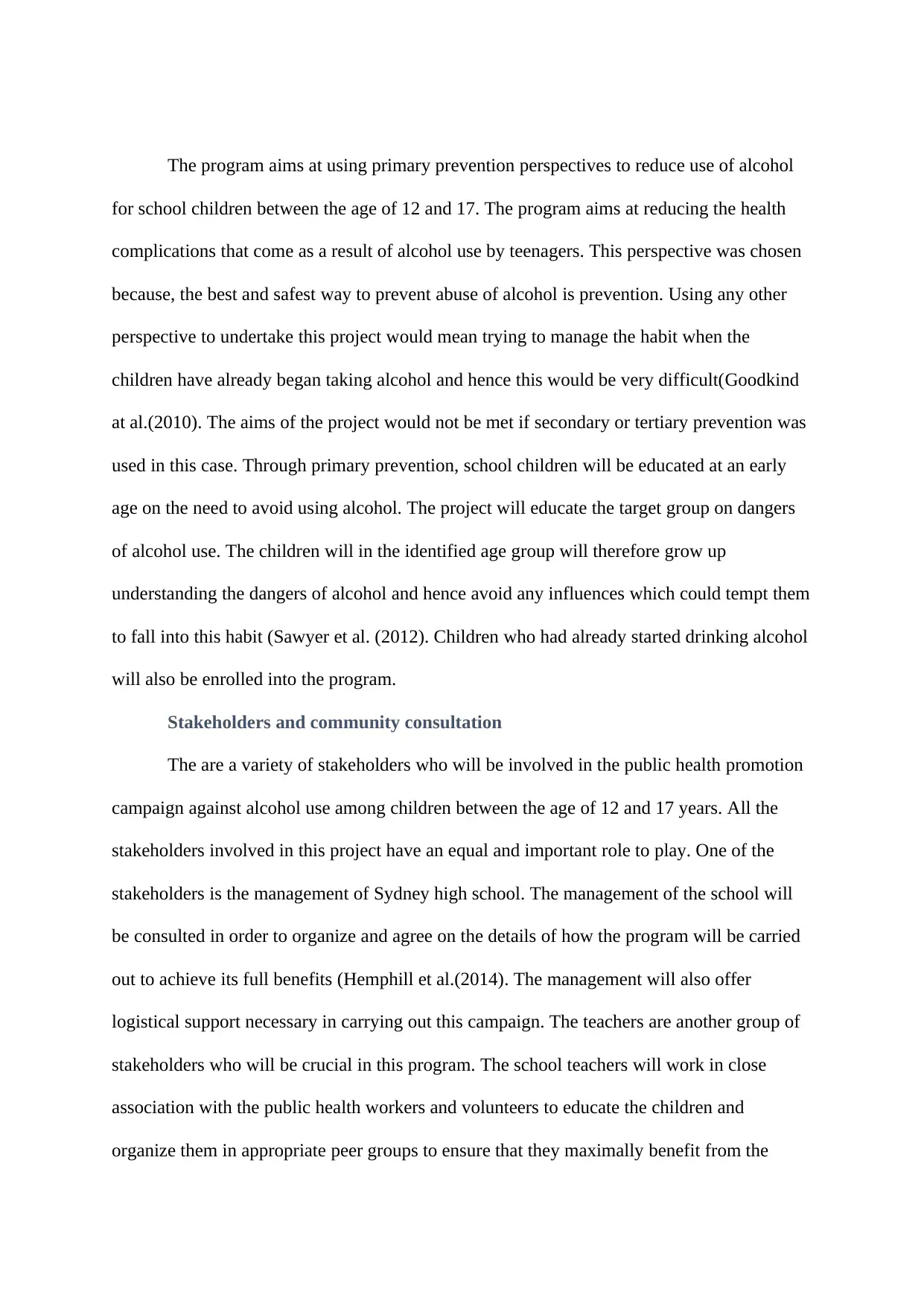
The program aims at using primary prevention perspectives to reduce use of alcohol
for school children between the age of 12 and 17. The program aims at reducing the health
complications that come as a result of alcohol use by teenagers. This perspective was chosen
because, the best and safest way to prevent abuse of alcohol is prevention. Using any other
perspective to undertake this project would mean trying to manage the habit when the
children have already began taking alcohol and hence this would be very difficult(Goodkind
at al.(2010). The aims of the project would not be met if secondary or tertiary prevention was
used in this case. Through primary prevention, school children will be educated at an early
age on the need to avoid using alcohol. The project will educate the target group on dangers
of alcohol use. The children will in the identified age group will therefore grow up
understanding the dangers of alcohol and hence avoid any influences which could tempt them
to fall into this habit (Sawyer et al. (2012). Children who had already started drinking alcohol
will also be enrolled into the program.
Stakeholders and community consultation
The are a variety of stakeholders who will be involved in the public health promotion
campaign against alcohol use among children between the age of 12 and 17 years. All the
stakeholders involved in this project have an equal and important role to play. One of the
stakeholders is the management of Sydney high school. The management of the school will
be consulted in order to organize and agree on the details of how the program will be carried
out to achieve its full benefits (Hemphill et al.(2014). The management will also offer
logistical support necessary in carrying out this campaign. The teachers are another group of
stakeholders who will be crucial in this program. The school teachers will work in close
association with the public health workers and volunteers to educate the children and
organize them in appropriate peer groups to ensure that they maximally benefit from the
for school children between the age of 12 and 17. The program aims at reducing the health
complications that come as a result of alcohol use by teenagers. This perspective was chosen
because, the best and safest way to prevent abuse of alcohol is prevention. Using any other
perspective to undertake this project would mean trying to manage the habit when the
children have already began taking alcohol and hence this would be very difficult(Goodkind
at al.(2010). The aims of the project would not be met if secondary or tertiary prevention was
used in this case. Through primary prevention, school children will be educated at an early
age on the need to avoid using alcohol. The project will educate the target group on dangers
of alcohol use. The children will in the identified age group will therefore grow up
understanding the dangers of alcohol and hence avoid any influences which could tempt them
to fall into this habit (Sawyer et al. (2012). Children who had already started drinking alcohol
will also be enrolled into the program.
Stakeholders and community consultation
The are a variety of stakeholders who will be involved in the public health promotion
campaign against alcohol use among children between the age of 12 and 17 years. All the
stakeholders involved in this project have an equal and important role to play. One of the
stakeholders is the management of Sydney high school. The management of the school will
be consulted in order to organize and agree on the details of how the program will be carried
out to achieve its full benefits (Hemphill et al.(2014). The management will also offer
logistical support necessary in carrying out this campaign. The teachers are another group of
stakeholders who will be crucial in this program. The school teachers will work in close
association with the public health workers and volunteers to educate the children and
organize them in appropriate peer groups to ensure that they maximally benefit from the
Paraphrase This Document
Need a fresh take? Get an instant paraphrase of this document with our AI Paraphraser
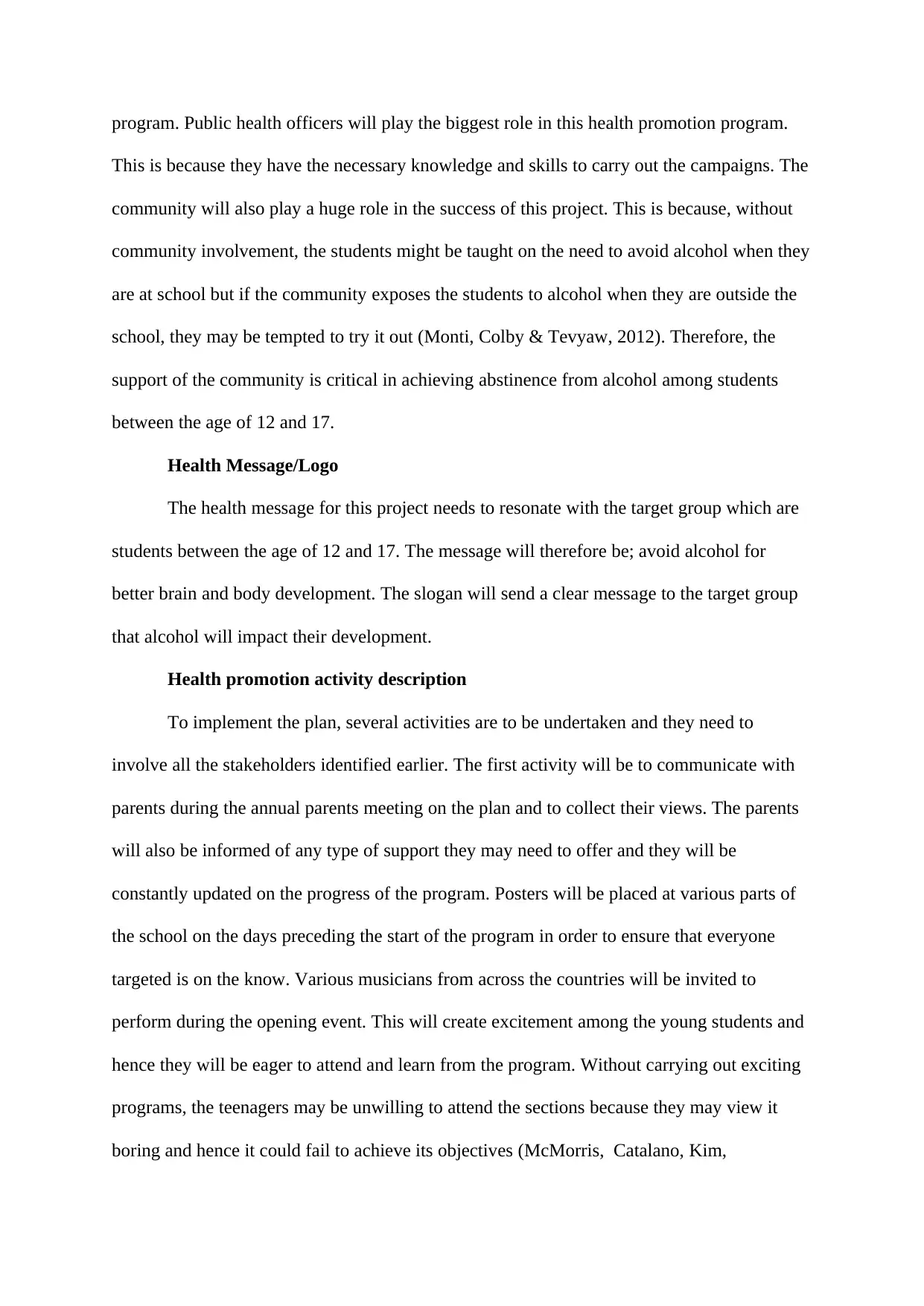
program. Public health officers will play the biggest role in this health promotion program.
This is because they have the necessary knowledge and skills to carry out the campaigns. The
community will also play a huge role in the success of this project. This is because, without
community involvement, the students might be taught on the need to avoid alcohol when they
are at school but if the community exposes the students to alcohol when they are outside the
school, they may be tempted to try it out (Monti, Colby & Tevyaw, 2012). Therefore, the
support of the community is critical in achieving abstinence from alcohol among students
between the age of 12 and 17.
Health Message/Logo
The health message for this project needs to resonate with the target group which are
students between the age of 12 and 17. The message will therefore be; avoid alcohol for
better brain and body development. The slogan will send a clear message to the target group
that alcohol will impact their development.
Health promotion activity description
To implement the plan, several activities are to be undertaken and they need to
involve all the stakeholders identified earlier. The first activity will be to communicate with
parents during the annual parents meeting on the plan and to collect their views. The parents
will also be informed of any type of support they may need to offer and they will be
constantly updated on the progress of the program. Posters will be placed at various parts of
the school on the days preceding the start of the program in order to ensure that everyone
targeted is on the know. Various musicians from across the countries will be invited to
perform during the opening event. This will create excitement among the young students and
hence they will be eager to attend and learn from the program. Without carrying out exciting
programs, the teenagers may be unwilling to attend the sections because they may view it
boring and hence it could fail to achieve its objectives (McMorris, Catalano, Kim,
This is because they have the necessary knowledge and skills to carry out the campaigns. The
community will also play a huge role in the success of this project. This is because, without
community involvement, the students might be taught on the need to avoid alcohol when they
are at school but if the community exposes the students to alcohol when they are outside the
school, they may be tempted to try it out (Monti, Colby & Tevyaw, 2012). Therefore, the
support of the community is critical in achieving abstinence from alcohol among students
between the age of 12 and 17.
Health Message/Logo
The health message for this project needs to resonate with the target group which are
students between the age of 12 and 17. The message will therefore be; avoid alcohol for
better brain and body development. The slogan will send a clear message to the target group
that alcohol will impact their development.
Health promotion activity description
To implement the plan, several activities are to be undertaken and they need to
involve all the stakeholders identified earlier. The first activity will be to communicate with
parents during the annual parents meeting on the plan and to collect their views. The parents
will also be informed of any type of support they may need to offer and they will be
constantly updated on the progress of the program. Posters will be placed at various parts of
the school on the days preceding the start of the program in order to ensure that everyone
targeted is on the know. Various musicians from across the countries will be invited to
perform during the opening event. This will create excitement among the young students and
hence they will be eager to attend and learn from the program. Without carrying out exciting
programs, the teenagers may be unwilling to attend the sections because they may view it
boring and hence it could fail to achieve its objectives (McMorris, Catalano, Kim,
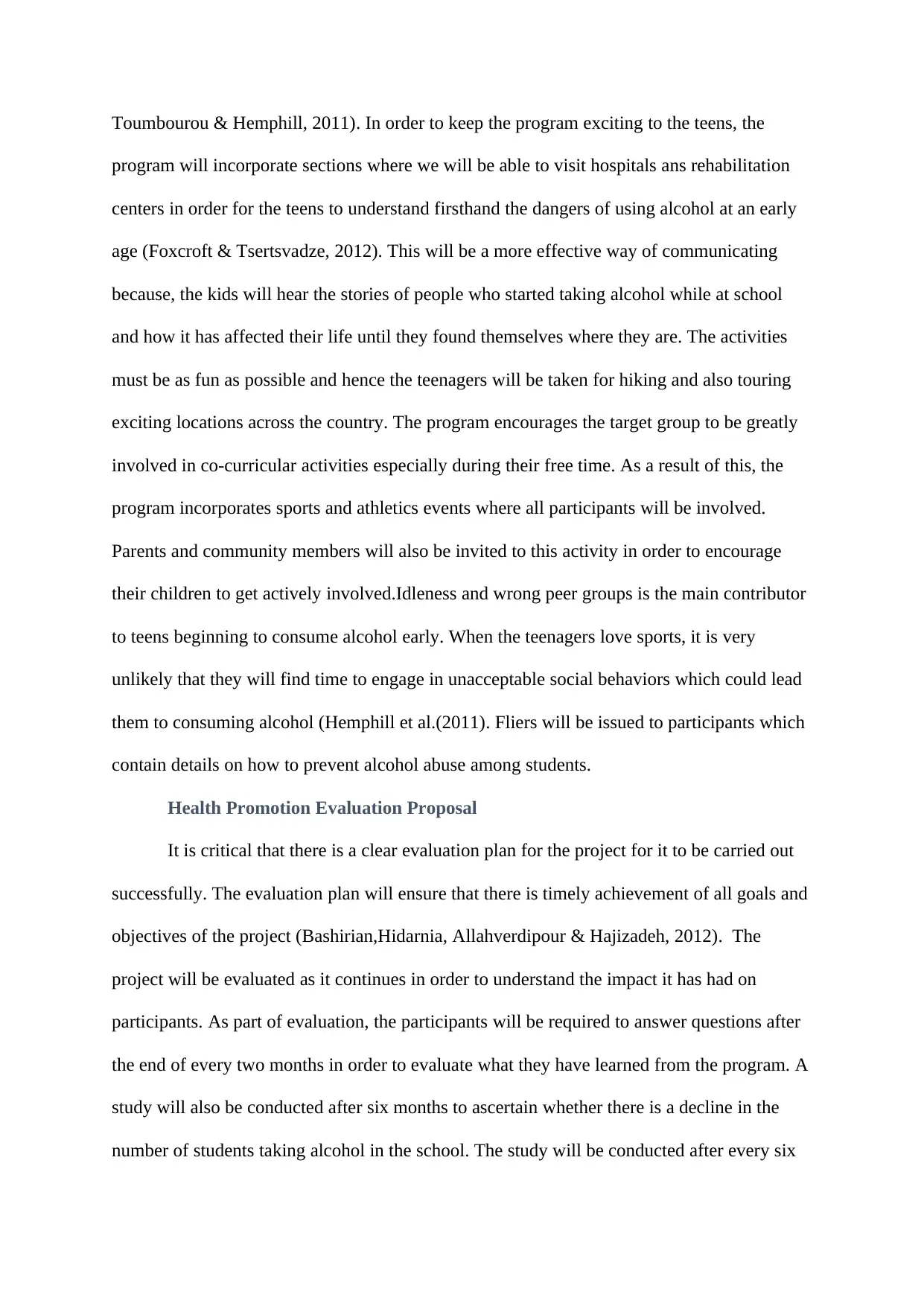
Toumbourou & Hemphill, 2011). In order to keep the program exciting to the teens, the
program will incorporate sections where we will be able to visit hospitals ans rehabilitation
centers in order for the teens to understand firsthand the dangers of using alcohol at an early
age (Foxcroft & Tsertsvadze, 2012). This will be a more effective way of communicating
because, the kids will hear the stories of people who started taking alcohol while at school
and how it has affected their life until they found themselves where they are. The activities
must be as fun as possible and hence the teenagers will be taken for hiking and also touring
exciting locations across the country. The program encourages the target group to be greatly
involved in co-curricular activities especially during their free time. As a result of this, the
program incorporates sports and athletics events where all participants will be involved.
Parents and community members will also be invited to this activity in order to encourage
their children to get actively involved.Idleness and wrong peer groups is the main contributor
to teens beginning to consume alcohol early. When the teenagers love sports, it is very
unlikely that they will find time to engage in unacceptable social behaviors which could lead
them to consuming alcohol (Hemphill et al.(2011). Fliers will be issued to participants which
contain details on how to prevent alcohol abuse among students.
Health Promotion Evaluation Proposal
It is critical that there is a clear evaluation plan for the project for it to be carried out
successfully. The evaluation plan will ensure that there is timely achievement of all goals and
objectives of the project (Bashirian,Hidarnia, Allahverdipour & Hajizadeh, 2012). The
project will be evaluated as it continues in order to understand the impact it has had on
participants. As part of evaluation, the participants will be required to answer questions after
the end of every two months in order to evaluate what they have learned from the program. A
study will also be conducted after six months to ascertain whether there is a decline in the
number of students taking alcohol in the school. The study will be conducted after every six
program will incorporate sections where we will be able to visit hospitals ans rehabilitation
centers in order for the teens to understand firsthand the dangers of using alcohol at an early
age (Foxcroft & Tsertsvadze, 2012). This will be a more effective way of communicating
because, the kids will hear the stories of people who started taking alcohol while at school
and how it has affected their life until they found themselves where they are. The activities
must be as fun as possible and hence the teenagers will be taken for hiking and also touring
exciting locations across the country. The program encourages the target group to be greatly
involved in co-curricular activities especially during their free time. As a result of this, the
program incorporates sports and athletics events where all participants will be involved.
Parents and community members will also be invited to this activity in order to encourage
their children to get actively involved.Idleness and wrong peer groups is the main contributor
to teens beginning to consume alcohol early. When the teenagers love sports, it is very
unlikely that they will find time to engage in unacceptable social behaviors which could lead
them to consuming alcohol (Hemphill et al.(2011). Fliers will be issued to participants which
contain details on how to prevent alcohol abuse among students.
Health Promotion Evaluation Proposal
It is critical that there is a clear evaluation plan for the project for it to be carried out
successfully. The evaluation plan will ensure that there is timely achievement of all goals and
objectives of the project (Bashirian,Hidarnia, Allahverdipour & Hajizadeh, 2012). The
project will be evaluated as it continues in order to understand the impact it has had on
participants. As part of evaluation, the participants will be required to answer questions after
the end of every two months in order to evaluate what they have learned from the program. A
study will also be conducted after six months to ascertain whether there is a decline in the
number of students taking alcohol in the school. The study will be conducted after every six
⊘ This is a preview!⊘
Do you want full access?
Subscribe today to unlock all pages.

Trusted by 1+ million students worldwide
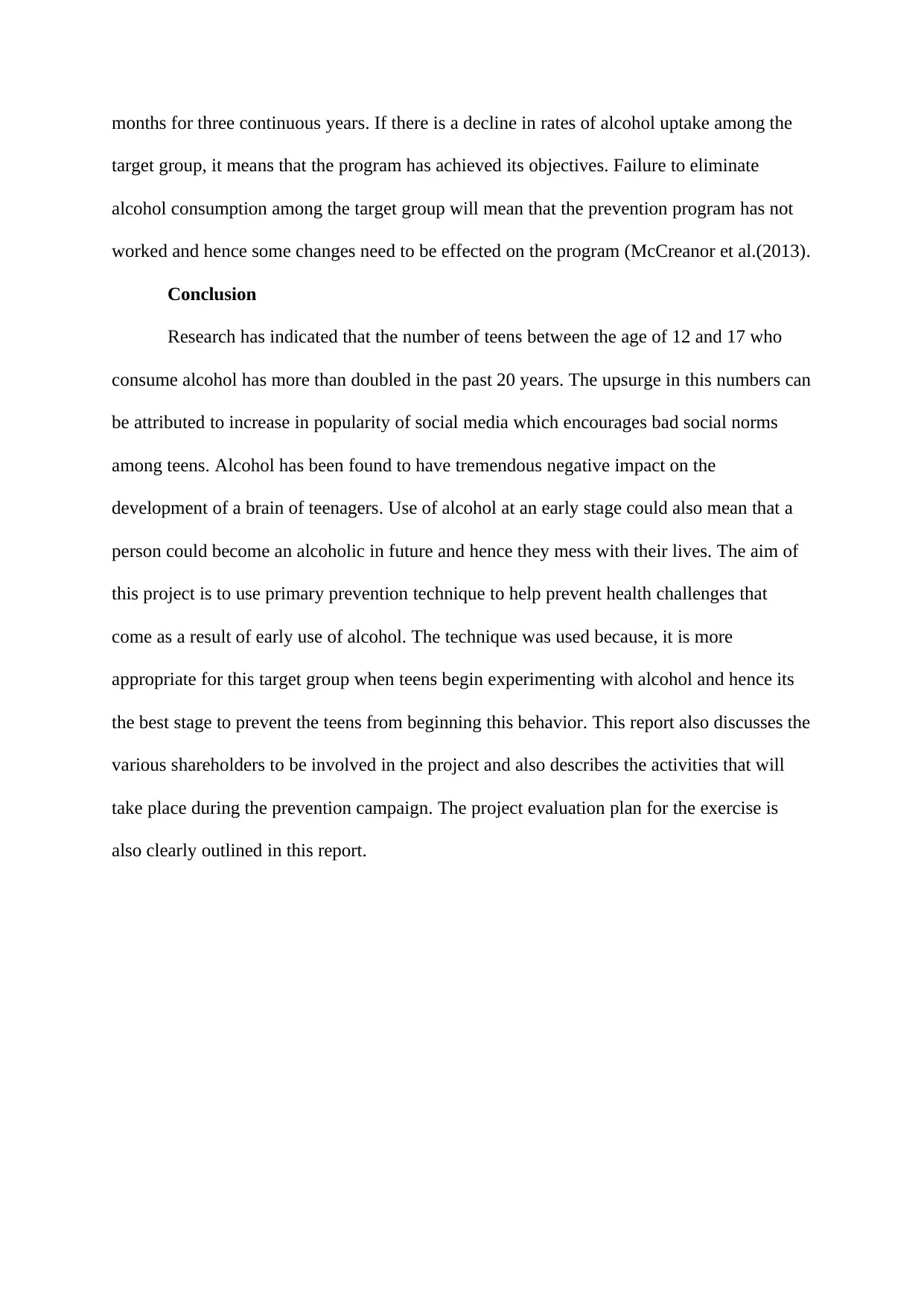
months for three continuous years. If there is a decline in rates of alcohol uptake among the
target group, it means that the program has achieved its objectives. Failure to eliminate
alcohol consumption among the target group will mean that the prevention program has not
worked and hence some changes need to be effected on the program (McCreanor et al.(2013).
Conclusion
Research has indicated that the number of teens between the age of 12 and 17 who
consume alcohol has more than doubled in the past 20 years. The upsurge in this numbers can
be attributed to increase in popularity of social media which encourages bad social norms
among teens. Alcohol has been found to have tremendous negative impact on the
development of a brain of teenagers. Use of alcohol at an early stage could also mean that a
person could become an alcoholic in future and hence they mess with their lives. The aim of
this project is to use primary prevention technique to help prevent health challenges that
come as a result of early use of alcohol. The technique was used because, it is more
appropriate for this target group when teens begin experimenting with alcohol and hence its
the best stage to prevent the teens from beginning this behavior. This report also discusses the
various shareholders to be involved in the project and also describes the activities that will
take place during the prevention campaign. The project evaluation plan for the exercise is
also clearly outlined in this report.
target group, it means that the program has achieved its objectives. Failure to eliminate
alcohol consumption among the target group will mean that the prevention program has not
worked and hence some changes need to be effected on the program (McCreanor et al.(2013).
Conclusion
Research has indicated that the number of teens between the age of 12 and 17 who
consume alcohol has more than doubled in the past 20 years. The upsurge in this numbers can
be attributed to increase in popularity of social media which encourages bad social norms
among teens. Alcohol has been found to have tremendous negative impact on the
development of a brain of teenagers. Use of alcohol at an early stage could also mean that a
person could become an alcoholic in future and hence they mess with their lives. The aim of
this project is to use primary prevention technique to help prevent health challenges that
come as a result of early use of alcohol. The technique was used because, it is more
appropriate for this target group when teens begin experimenting with alcohol and hence its
the best stage to prevent the teens from beginning this behavior. This report also discusses the
various shareholders to be involved in the project and also describes the activities that will
take place during the prevention campaign. The project evaluation plan for the exercise is
also clearly outlined in this report.
Paraphrase This Document
Need a fresh take? Get an instant paraphrase of this document with our AI Paraphraser
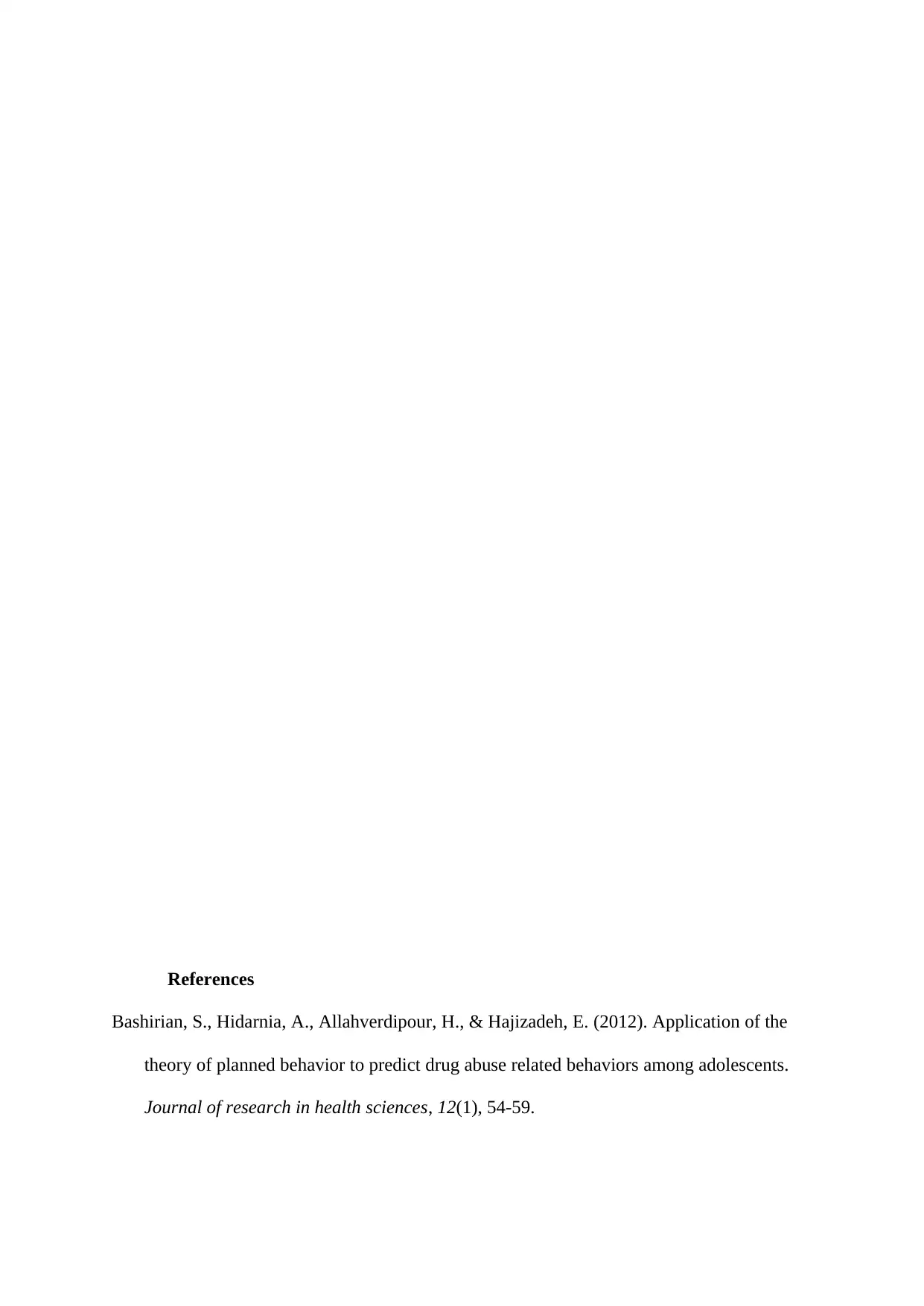
References
Bashirian, S., Hidarnia, A., Allahverdipour, H., & Hajizadeh, E. (2012). Application of the
theory of planned behavior to predict drug abuse related behaviors among adolescents.
Journal of research in health sciences, 12(1), 54-59.
Bashirian, S., Hidarnia, A., Allahverdipour, H., & Hajizadeh, E. (2012). Application of the
theory of planned behavior to predict drug abuse related behaviors among adolescents.
Journal of research in health sciences, 12(1), 54-59.
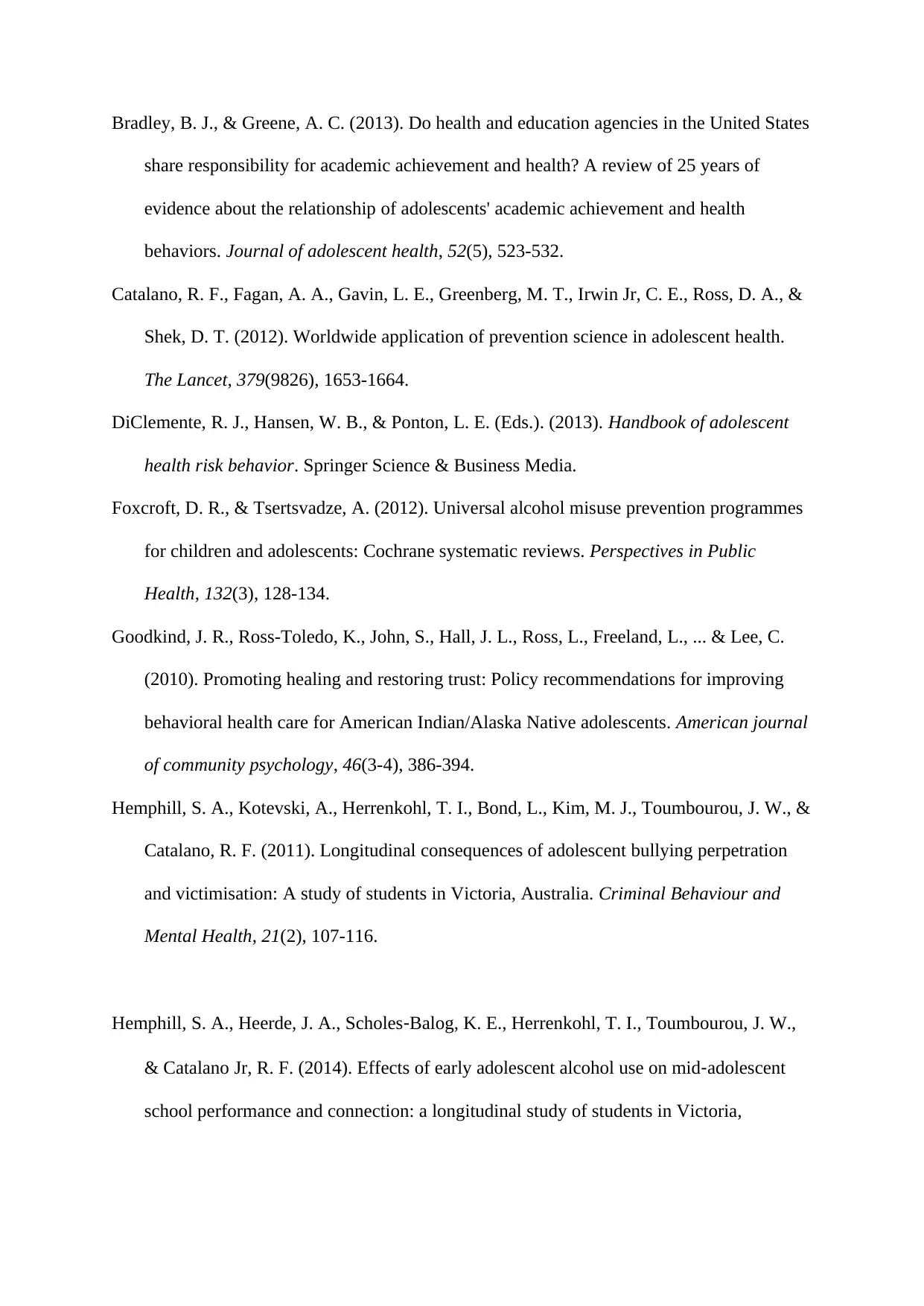
Bradley, B. J., & Greene, A. C. (2013). Do health and education agencies in the United States
share responsibility for academic achievement and health? A review of 25 years of
evidence about the relationship of adolescents' academic achievement and health
behaviors. Journal of adolescent health, 52(5), 523-532.
Catalano, R. F., Fagan, A. A., Gavin, L. E., Greenberg, M. T., Irwin Jr, C. E., Ross, D. A., &
Shek, D. T. (2012). Worldwide application of prevention science in adolescent health.
The Lancet, 379(9826), 1653-1664.
DiClemente, R. J., Hansen, W. B., & Ponton, L. E. (Eds.). (2013). Handbook of adolescent
health risk behavior. Springer Science & Business Media.
Foxcroft, D. R., & Tsertsvadze, A. (2012). Universal alcohol misuse prevention programmes
for children and adolescents: Cochrane systematic reviews. Perspectives in Public
Health, 132(3), 128-134.
Goodkind, J. R., Ross-Toledo, K., John, S., Hall, J. L., Ross, L., Freeland, L., ... & Lee, C.
(2010). Promoting healing and restoring trust: Policy recommendations for improving
behavioral health care for American Indian/Alaska Native adolescents. American journal
of community psychology, 46(3-4), 386-394.
Hemphill, S. A., Kotevski, A., Herrenkohl, T. I., Bond, L., Kim, M. J., Toumbourou, J. W., &
Catalano, R. F. (2011). Longitudinal consequences of adolescent bullying perpetration
and victimisation: A study of students in Victoria, Australia. Criminal Behaviour and
Mental Health, 21(2), 107-116.
Hemphill, S. A., Heerde, J. A., Scholes‐Balog, K. E., Herrenkohl, T. I., Toumbourou, J. W.,
& Catalano Jr, R. F. (2014). Effects of early adolescent alcohol use on mid‐adolescent
school performance and connection: a longitudinal study of students in Victoria,
share responsibility for academic achievement and health? A review of 25 years of
evidence about the relationship of adolescents' academic achievement and health
behaviors. Journal of adolescent health, 52(5), 523-532.
Catalano, R. F., Fagan, A. A., Gavin, L. E., Greenberg, M. T., Irwin Jr, C. E., Ross, D. A., &
Shek, D. T. (2012). Worldwide application of prevention science in adolescent health.
The Lancet, 379(9826), 1653-1664.
DiClemente, R. J., Hansen, W. B., & Ponton, L. E. (Eds.). (2013). Handbook of adolescent
health risk behavior. Springer Science & Business Media.
Foxcroft, D. R., & Tsertsvadze, A. (2012). Universal alcohol misuse prevention programmes
for children and adolescents: Cochrane systematic reviews. Perspectives in Public
Health, 132(3), 128-134.
Goodkind, J. R., Ross-Toledo, K., John, S., Hall, J. L., Ross, L., Freeland, L., ... & Lee, C.
(2010). Promoting healing and restoring trust: Policy recommendations for improving
behavioral health care for American Indian/Alaska Native adolescents. American journal
of community psychology, 46(3-4), 386-394.
Hemphill, S. A., Kotevski, A., Herrenkohl, T. I., Bond, L., Kim, M. J., Toumbourou, J. W., &
Catalano, R. F. (2011). Longitudinal consequences of adolescent bullying perpetration
and victimisation: A study of students in Victoria, Australia. Criminal Behaviour and
Mental Health, 21(2), 107-116.
Hemphill, S. A., Heerde, J. A., Scholes‐Balog, K. E., Herrenkohl, T. I., Toumbourou, J. W.,
& Catalano Jr, R. F. (2014). Effects of early adolescent alcohol use on mid‐adolescent
school performance and connection: a longitudinal study of students in Victoria,
⊘ This is a preview!⊘
Do you want full access?
Subscribe today to unlock all pages.

Trusted by 1+ million students worldwide
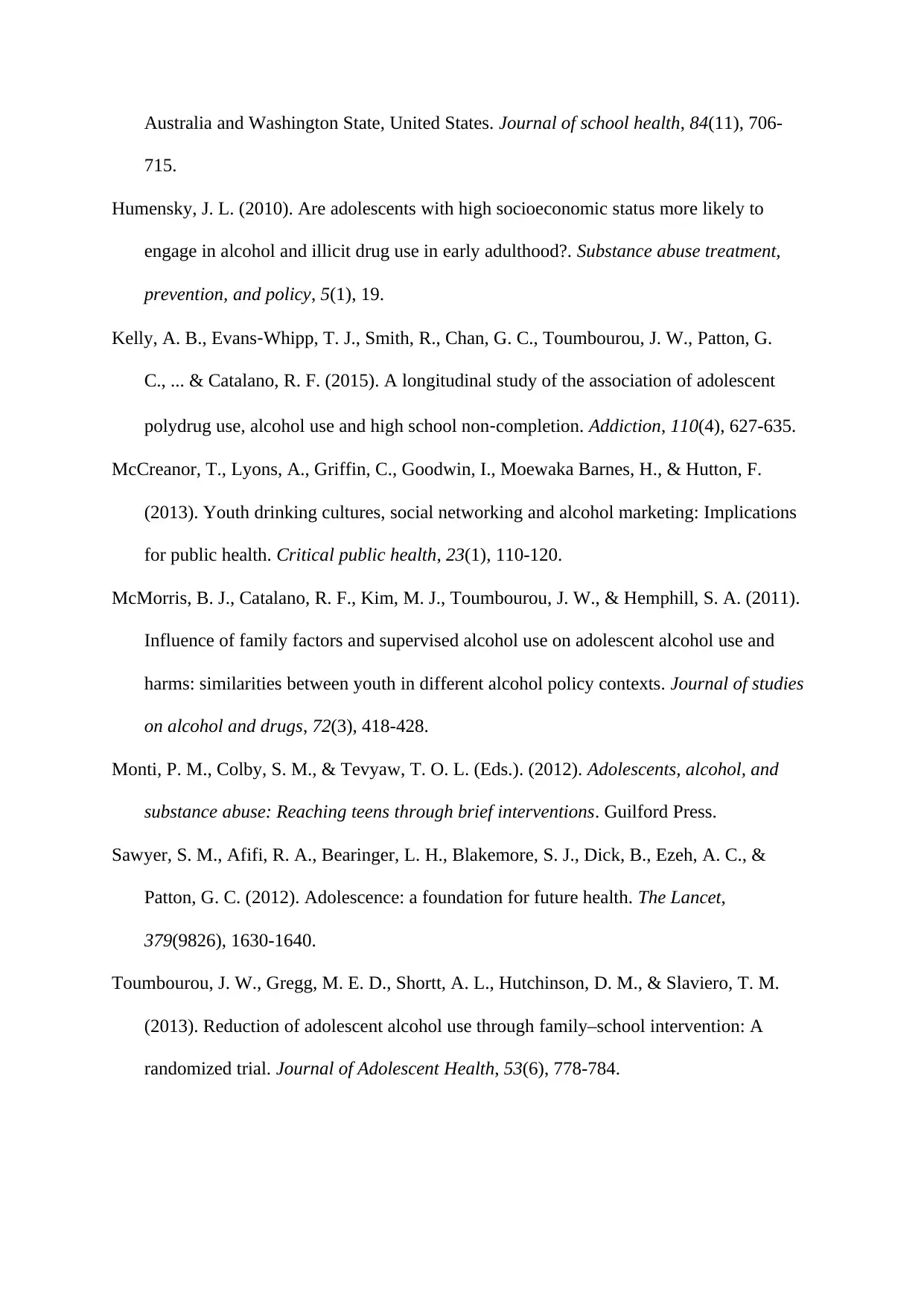
Australia and Washington State, United States. Journal of school health, 84(11), 706-
715.
Humensky, J. L. (2010). Are adolescents with high socioeconomic status more likely to
engage in alcohol and illicit drug use in early adulthood?. Substance abuse treatment,
prevention, and policy, 5(1), 19.
Kelly, A. B., Evans‐Whipp, T. J., Smith, R., Chan, G. C., Toumbourou, J. W., Patton, G.
C., ... & Catalano, R. F. (2015). A longitudinal study of the association of adolescent
polydrug use, alcohol use and high school non‐completion. Addiction, 110(4), 627-635.
McCreanor, T., Lyons, A., Griffin, C., Goodwin, I., Moewaka Barnes, H., & Hutton, F.
(2013). Youth drinking cultures, social networking and alcohol marketing: Implications
for public health. Critical public health, 23(1), 110-120.
McMorris, B. J., Catalano, R. F., Kim, M. J., Toumbourou, J. W., & Hemphill, S. A. (2011).
Influence of family factors and supervised alcohol use on adolescent alcohol use and
harms: similarities between youth in different alcohol policy contexts. Journal of studies
on alcohol and drugs, 72(3), 418-428.
Monti, P. M., Colby, S. M., & Tevyaw, T. O. L. (Eds.). (2012). Adolescents, alcohol, and
substance abuse: Reaching teens through brief interventions. Guilford Press.
Sawyer, S. M., Afifi, R. A., Bearinger, L. H., Blakemore, S. J., Dick, B., Ezeh, A. C., &
Patton, G. C. (2012). Adolescence: a foundation for future health. The Lancet,
379(9826), 1630-1640.
Toumbourou, J. W., Gregg, M. E. D., Shortt, A. L., Hutchinson, D. M., & Slaviero, T. M.
(2013). Reduction of adolescent alcohol use through family–school intervention: A
randomized trial. Journal of Adolescent Health, 53(6), 778-784.
715.
Humensky, J. L. (2010). Are adolescents with high socioeconomic status more likely to
engage in alcohol and illicit drug use in early adulthood?. Substance abuse treatment,
prevention, and policy, 5(1), 19.
Kelly, A. B., Evans‐Whipp, T. J., Smith, R., Chan, G. C., Toumbourou, J. W., Patton, G.
C., ... & Catalano, R. F. (2015). A longitudinal study of the association of adolescent
polydrug use, alcohol use and high school non‐completion. Addiction, 110(4), 627-635.
McCreanor, T., Lyons, A., Griffin, C., Goodwin, I., Moewaka Barnes, H., & Hutton, F.
(2013). Youth drinking cultures, social networking and alcohol marketing: Implications
for public health. Critical public health, 23(1), 110-120.
McMorris, B. J., Catalano, R. F., Kim, M. J., Toumbourou, J. W., & Hemphill, S. A. (2011).
Influence of family factors and supervised alcohol use on adolescent alcohol use and
harms: similarities between youth in different alcohol policy contexts. Journal of studies
on alcohol and drugs, 72(3), 418-428.
Monti, P. M., Colby, S. M., & Tevyaw, T. O. L. (Eds.). (2012). Adolescents, alcohol, and
substance abuse: Reaching teens through brief interventions. Guilford Press.
Sawyer, S. M., Afifi, R. A., Bearinger, L. H., Blakemore, S. J., Dick, B., Ezeh, A. C., &
Patton, G. C. (2012). Adolescence: a foundation for future health. The Lancet,
379(9826), 1630-1640.
Toumbourou, J. W., Gregg, M. E. D., Shortt, A. L., Hutchinson, D. M., & Slaviero, T. M.
(2013). Reduction of adolescent alcohol use through family–school intervention: A
randomized trial. Journal of Adolescent Health, 53(6), 778-784.
1 out of 10
Related Documents
Your All-in-One AI-Powered Toolkit for Academic Success.
+13062052269
info@desklib.com
Available 24*7 on WhatsApp / Email
![[object Object]](/_next/static/media/star-bottom.7253800d.svg)
Unlock your academic potential
Copyright © 2020–2025 A2Z Services. All Rights Reserved. Developed and managed by ZUCOL.




